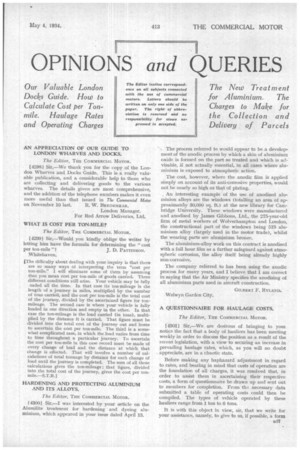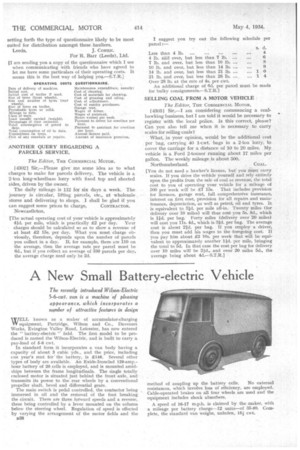OPINIONS and QUERIES
Page 51

Page 52

If you've noticed an error in this article please click here to report it so we can fix it.
AN APPRECIATION OF OUR GUIDE TO LONDON WHARVES AND DOCKS.
The Editor, THE COMMERCIAL MOTOR.
[42981 Sir,—We thank you for the copy of the London Wharves and Docks Guide. This is a really valuable publication, and a considerable help to those who are collecting and delivering goods to the various wharves. The details given are most comprehensive, and the addition of the telephone numbers makes it even more useful than that issued in The Commercial Motor
on November 10 last. R. W. BREDEMEAR, London Manager.
For Red Arrow Deliveries, Ltd.
WHAT IS COST PER TON-MILE?
The Editor, THE COMMERCIAL MOTOR.
[4299] Sir,—Would you kindly oblige the writer by letting him have the formula for determining the "cost per ton-mile "? J. D. PATTINSON. Whitehaveri.
[The difficulty about dealing with your inquiry is that there are so many ways of interpreting the term "cost per ton-mile." I will eliminate some of them by assuming that you mean cost per ton-mile of goods carried. Three different conditions still arise. Your vehicle may be fully oaded all the time. In that case its ton-mileage is the length of a journey in miles, multiplied by the number of tons carried, and the cost per ton-mile is the total cost of the journey, divided by the ascertained figure for tonmileage. The second case is where your vehicle is fully loaded in one direction and empty in the other. In that case the ton-mileage is the load carried (in tons), multiplied by the distance it is carried. That figure must be divided into the total cost of the journey out and home to ascertain the cost per ton-mile. The third is a somewhat complicated case, in which the load varies from time to time throughout a particular journey. To ascertain the cost per ton-mile in this case record must he made of every change of load and the distance at which that change is effected. That will involve a number of calculations of total tonnage by distance for each change of load until the journey is completed. The sum of all those calculations gives the ton-mileage ; that figure, divided into the total cost of the journey, gives the cost per tonmile.—S.T.R.]
HARDENING AND PROTECTING ALUMINIUM AND ITS ALLOYS.
The Editor, THE COMMERCIAL MOTOR.
14300] Sir,—I was interested by your article on the Kum-Ante treatment for hardening and dyeing aluminium, which appeared in your issue dated April 13. The process referred to would appear to be a development of the anodic process by which a skin of aluminium oxide is formed on the part so treated and which is advisable, if not actually essential, in all cases where aluminium is exposed to atmospheric action.
The cost, however, where the anodic film is applied simply on account of its anti-corrosive properties, would not be nearly so high as that of plating.
An interesting example of the use of anodised aluminion alloys are the windows (totalling an area of approximately 30,000 sq. ft.) at the new library for Cambridge University. These windows were manufactured and anodised by James Gibbons, Ltd., the 275-year-old firm of metal workers of Wolverhampton and London, the constructional part of the windows being 51S aluminium alloy (largely used in the motor trade), whilst the wearing parts are aluminium bronze.
The aluminium-alloy work on this contract is anodised With a full hour film as a further safeguard against atmospheric corrosion, the alloy itself being already highly non-corrosive.
The company referred to has been using the anodic process for many years, and I believe that I am correct in saying that the Air Ministry specifies the anodising of all aluminium parts used in aircraft construction.
GILBERT F. RYLAND.
Welwyn Garden City.
A QUESTIONNAIRE FOR HAULAGE COSTS.
The Editor, TITE COMMERCIAL MOTOR.
[43011 Sir,—We are desirous of bringing to your notice the fact that a body of hauliers has been meeting weekly in order to discuss the position as a result of the recent legislation, with a view to securing an increase in prevailing haulage rates, which, as you will no doubt appreciate, are in a chaotic state.
Before making any haphazard adjustment in regard to rates, and bearing in mind that costs of operation are the foundation of all charges, it was resolved that, in order to assist them in ascertaining their respective costs, a form of questionnaire be drawn up and sent out to members for completion. From the necessary data submitted a table of operating costs could then be compiled. The types of vehicle operated by these hauliers range from 1 ton to 6 tons.
It is with this object in view, sir, that we write for your assistance, namely, to give to us, if possible, a form setting forth the type of questionnaire likely to be most suited for distribution amongst these hauliers.
Leeds. J. ConEN.
For R. Barr (Leeds), Ltd.
[I am sending you a copy of the questionnaire which I use when communicating with friends who have agreed to let me have some particulars of their operating costs. It seems this is the best way of helping you.—S.T.R.] ANOTHER QUERY REGARDING A PARCELS SERVICE.
The Editor, THE COMMERCIAL MOTOR.
[4302] Sir,—Please give me some idea as to what charges to make for parcels delivery. The vehicle is a 2-ton long-wheelbase lorry with fixed top and sheeted sides, driven by the owner.
The daily mileage is 112 for six days a week. The journey is circular, lifting parcels, etc., at wholesale .
stores and delivering to shops. .I shall be glad if you can suggest some prices to charge. CONTRACTOR. Newcastleton.
[The actual operating cost of your vehicle is approximately 41d. per mile, which is practically £2 per day. Your charges should be calculated so as to show a revenue of at least £2 15s. per day. What you most charge obviously, therefore, depends upon the number of parcels you collect in a day. If, for example, there are 110 on the average, then the average rate per parcel must be 6d., but if you collect an average of 380 parcels per day, the average charge need only be 2d. An additional charge of 6d. per parcel must be made for bulky consignments.—S.T.R.]
SELLING COAL FROM A MOTOR VEHICLE
The Editor, THE COMMERCIAL MOTOR.
143031 Sir,—I am considering commencing a coalhawking business, but I am told it would be necessary to register with the local police. Is this correct, please? Can you also tell me when it is necessary to carry scales for selling coals?
What, in your opinion, would be the additional cost per bag, carrying 40 1-cwt. bags in a 2-ton lorry, to cover the carriage for a distance of 10 to 20 miles. My vehicle is a Ford 2-tonner running about 17 miles per gallon. The weekly mileage is about 500.
Northumberland. COAL.
[You do not need a hawker's licence, but you rilust carry scales, If you drive the vehicle yourself and rely entirely upon the profits from the sale of coal as revenue, the total cost to you of operating your vehicle for a mileage of 500 per week will be £7 15s, That includes provision for licences, garage rent, full comprehensive insurance, interest on first cost, provision for all repairs and maintenance, depreciation, as well as petrol, oil and tyres. It is equivalent to 31d. per mile all-in. Twenty miles (for delivery over 10 miles) will thus cost you 5s. 8d., which is lid. per bag. Forty miles (delivery over 20 miles) will cost you lie. 4d., which is 31d. per bag. The average cost is about 21d. per bag. If you employ a driver, then you must add his wages to the foregoing cost. If you pay him about £2 10s, per week that will be equivalent to approximately another 1/d. per mile, bringing the total to 5d. In that case the cost per bag for delivery over 10 miles will be 21d., and over 20 miles 5d., the average being about 4d.—S.T.R.]




























































































